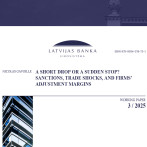Retail trade suffers yet supports growth
According to the data of the Central Statistical Bureau (CSB), the annual growth in the retail trade turnover in the second quarter of 2016 was 1.9% at constant prices. Already during the first quarter of the year, the growth of the branch was in part based on short-term factors and its annual rate of growth had dropped to 1.8%. Furthermore, the growth rate of the real net wage went down noticeably in the first quarter, which, on the side of demand, signals possible caution in purchases and that is why the latest retail trade indicators are not surprising.
In the second quarter, the positive contribution of fuel sales to the overall quarterly and annual retail growth resumed, yet the retail trade of many other goods slackened. Among the goods whose retail trade contracted were the ones related to home improvement (e.g., household electrical appliances, metal products, paints, glass), which dropped both year-on-year and quarter-on-quarter.
At the same time, the July data of consumer surveys suggest that consumers tend to make large purchases now instead of supposing that the appropriate time for that would be the next 12 months. Consumer thoughts on savings seem to be moving in the opposite direction. That means that the branch could hardly resume growing faster in the coming quarters.
According to the European Commission's survey data, the mood among retailers was nevertheless slightly more optimistic in the second quarter than at the beginning of the year and in July as well retailers look hopeful: the total confidence indicator remains slightly higher than on average over the last three years. Furthermore, the retailers of food, beverages and tobacco, for example, in the next three months project a rise in business activity and price level as well as a slight rise in employment, although in supermarkets, the introduction of self-service cash registers is growing more extensive.
The flash estimate data of retail turnover and gross domestic product (GDP) indicate that private consumption on the expenditure side could remain a driving force of growth this year as well, even though the drop in rates on both sides is obvious (the GDP flash estimate indicates that the annual growth rate in the second quarter could be a mere 0.7%) and that it would be difficult to improve any further without an influx of investments. Of course there is hope that, with the improvement in the uptake of EU funds and overcoming the difficulties related to the transition to the new planning period, situation in investments and thus in growth will improve.
Textual error
«… …»






